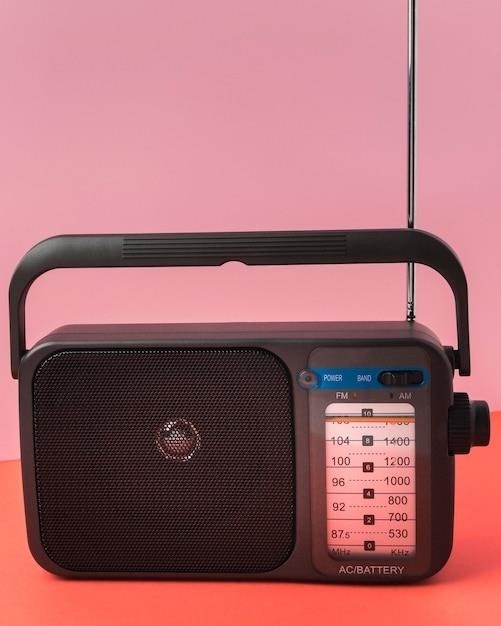
Midland WR-120 All Hazards Alert Weather Radio⁚ A Comprehensive Guide
Introduction
The Midland WR-120 All Hazards Alert Weather Radio is a vital tool for staying informed and safe during severe weather events and emergencies. This comprehensive guide will provide you with all the information you need to set up‚ program‚ and utilize your Midland WR-120 to its full potential. This user-friendly manual will guide you through the various features‚ settings‚ and functions of your radio‚ ensuring that you are prepared for any situation. From understanding S.A;M.E. technology to troubleshooting common issues‚ this guide will empower you to make the most of your Midland WR-120 and stay ahead of potential hazards.
Key Features of the Midland WR-120
The Midland WR-120 is a versatile weather alert radio packed with features designed to keep you safe and informed. Its key features include⁚
- All Hazards Alert⁚ The WR-120 receives alerts for a wide range of hazards‚ including tornadoes‚ hurricanes‚ floods‚ ice storms‚ and civil emergencies like AMBER Alerts.
- S.A.M.E. Technology (Specific Area Message Encoding)⁚ This innovative technology allows you to program your specific location to receive alerts targeted to your area‚ filtering out irrelevant broadcasts.
- Public Alert Certified⁚ The WR-120 meets the stringent requirements of the Public Alert certification‚ ensuring its reliability and effectiveness in delivering critical alerts.
- Multiple Alert Options⁚ The WR-120 offers various alert modes‚ including voice alerts‚ tone alerts‚ and display alerts‚ allowing you to choose the most suitable method for your needs.
- Easy Navigation⁚ The WR-120 features a user-friendly interface with clear menus and buttons‚ making it simple to navigate and program.
- Durable Design⁚ Built to withstand harsh conditions‚ the WR-120 is designed for reliability and long-lasting performance.
Setting Up the Midland WR-120
Setting up your Midland WR-120 is a straightforward process. The first step is to install the batteries‚ followed by initial programming. Here’s a step-by-step guide⁚
Battery Installation⁚ Locate the battery compartment on the underside of the radio and insert three AA alkaline batteries (not included). Ensure the batteries are inserted with the positive (+) end facing up. The batteries provide approximately 5 hours of emergency power or 75 hours of standby power in case of a power outage.
Initial Programming⁚ After inserting the batteries‚ turn on the radio using the ON/OFF switch. You’ll be prompted to set the language‚ country‚ time‚ and channel. Follow the on-screen instructions to complete the initial programming. It is essential to correctly program your location’s S.A.M.E. code for receiving targeted alerts.
Storing the Manual⁚ Once the radio is programmed and operating correctly‚ store the owner’s manual in a safe place for future reference.
Battery Installation
The Midland WR-120 requires three AA alkaline batteries (not included) to operate. To install the batteries‚ follow these steps⁚
Locate the Battery Compartment⁚ Turn the radio over and locate the battery compartment on the underside. You’ll see a small latch or a slide to open the compartment.
Insert the Batteries⁚ Insert the batteries into the compartment‚ making sure the positive (+) end of each battery is facing upwards. Align the batteries correctly within the compartment.
Close the Compartment⁚ Close the battery compartment securely‚ ensuring the latch or slide is properly engaged.
The batteries provide approximately 5 hours of emergency power or 75 hours of standby power for the radio in case of a power outage. It’s important to use fresh‚ high-quality batteries for optimal performance.

Initial Programming
Once you’ve installed the batteries‚ it’s time to program your Midland WR-120 for optimal use; This involves setting your preferred language‚ location‚ and other essential parameters. To get started‚ follow these steps⁚
Power On the Radio⁚ Turn on the radio by sliding the ON/OFF switch located on the right side of the unit to the “ON” position.
Access the Menu⁚ Press the “MENU” button on the radio to access the main menu. You’ll see a list of options on the LCD display. Use the arrow buttons (up and down) to navigate through the menu.
Set Your Language⁚ Select the “Language” option and use the arrow buttons to choose your preferred language from the list. Confirm your selection by pressing the “ENTER” button.
Set Your Country⁚ Choose the “Country” option and use the arrow buttons to select your country from the list. Confirm your selection by pressing the “ENTER” button.
Set Your Time⁚ Navigate to the “Time” option and use the arrow buttons to set the correct hour and minute. Press “ENTER” to confirm.
Set Your Channel⁚ Select the “Channel” option to choose the desired weather radio channel. Use the arrow buttons to navigate and press “ENTER” to confirm.
Adjust Volume and Brightness⁚ Use the volume up and volume down buttons to adjust the volume to a comfortable level. You can also adjust the brightness of the LCD display using the brightness button.
Understanding S.A.M.E. Technology
The Midland WR-120 incorporates S.A.M.E. (Specific Area Message Encoding) technology‚ a crucial feature that enhances the radio’s effectiveness in delivering targeted alerts. S.A.M.E. essentially allows the radio to filter out irrelevant broadcasts and receive alerts only for your specific location. This ensures you receive timely and accurate information about weather events or emergencies directly impacting your area.
Each county in the United States has a unique S.A.M.E. code. When you program your Midland WR-120‚ you’ll input the S.A.M.E. code for your county. This tells the radio which broadcasts to prioritize and which to ignore. By doing so‚ you eliminate the noise of unnecessary alerts‚ ensuring that you only receive alerts that are relevant to your immediate surroundings. This targeted approach makes the Midland WR-120 an invaluable tool for staying informed during severe weather or emergencies.
S.A.M.E. technology is a valuable component of the Midland WR-120’s functionality‚ enhancing its accuracy and relevance. By filtering out irrelevant broadcasts‚ you ensure that you receive only the critical information you need to stay safe and informed.
Types of Alerts
The Midland WR-120 offers a range of alert types to keep you informed of various emergencies and weather conditions. The radio’s alert system is designed to provide you with the most relevant and timely information‚ ensuring you’re prepared for any situation.
One of the most critical alert types is the weather alert. This alert notifies you of severe weather events such as tornadoes‚ hurricanes‚ floods‚ and winter storms. The radio receives these alerts directly from the National Oceanic and Atmospheric Administration (NOAA) weather radio network‚ ensuring that you have the most up-to-date information.
In addition to weather alerts‚ the Midland WR-120 also provides emergency alerts. These alerts inform you about various emergencies‚ including AMBER Alerts for missing children‚ public safety announcements‚ and other critical information. The radio’s emergency alert system is designed to provide you with the information you need to stay safe and informed during a crisis.
The Midland WR-120’s alert system is designed to keep you informed about a wide range of potential threats. The radio’s ability to receive both weather and emergency alerts makes it an essential tool for staying safe and prepared in any situation.
Programming Your Location
To ensure you receive the most relevant alerts‚ it’s crucial to program your location into the Midland WR-120. The radio utilizes S.A.M.E. (Specific Area Message Encoding) technology‚ which allows it to filter alerts based on your specific location. This means you’ll only receive alerts for your area‚ eliminating unnecessary notifications.
The process of programming your location is straightforward and typically involves inputting your county or region’s S.A.M.E. code. These codes are unique identifiers for each location‚ and you can find them online or in the Midland WR-120’s user manual. Once you’ve located your S.A.M.E. code‚ simply navigate to the radio’s programming menu‚ select the “Location” option‚ and enter the code.
Programming your location is a crucial step in setting up your Midland WR-120. It ensures that you receive only the alerts that are relevant to your area‚ optimizing the radio’s effectiveness and minimizing unnecessary interruptions. By taking the time to program your location‚ you’ll be better prepared for any potential weather or emergency events.
Using the Midland WR-120
Once you’ve set up your Midland WR-120‚ you’re ready to start using it. The radio is designed for user-friendliness‚ with intuitive controls and a clear display. The primary functions include navigating the menu‚ adjusting volume and brightness‚ and testing the alarm.
Navigating the menu is done using the buttons on the radio’s front panel. These buttons allow you to scroll through different settings‚ such as channel selection‚ alert preferences‚ and time settings. You can adjust the volume and brightness of the radio to suit your preference. The volume buttons allow you to control the audio output‚ while the brightness buttons adjust the display’s intensity.
To ensure your radio is functioning correctly‚ you can test the alarm system. This allows you to hear the alarm sound and verify that it’s working properly. The Midland WR-120 is a valuable tool for staying informed about weather and emergency situations. Familiarize yourself with its features and functions to maximize its benefits and ensure your safety during critical events.
Navigating the Menu
The Midland WR-120 features a user-friendly menu system that allows you to easily access and adjust various settings. To navigate the menu‚ use the buttons located on the front panel of the radio. The menu system is organized into different sections‚ each dedicated to a specific function.
To access the menu‚ press the “MENU” button. This will display the main menu on the LCD screen. Use the up and down arrow buttons to scroll through the available menu options. The “ENTER” button selects the highlighted option‚ allowing you to access its settings.
Once you’ve entered a specific menu section‚ you can use the arrow buttons to adjust the settings. For example‚ you can use the arrow buttons to select a specific channel‚ adjust the alarm tone‚ or set the time. The menu system is intuitive and straightforward‚ making it easy to customize the WR-120 to meet your specific needs.
Adjusting Volume and Brightness
The Midland WR-120 allows you to customize the volume and brightness of the display to suit your preferences and listening environment. To adjust the volume‚ use the “VOLUME” buttons located on the front panel of the radio. Press the “VOLUME UP” button to increase the volume or the “VOLUME DOWN” button to decrease it. The volume level is displayed on the LCD screen‚ allowing you to monitor the current setting.
To adjust the brightness of the display‚ press and hold the “MENU” button for a few seconds. This will bring up the brightness adjustment menu. Use the up and down arrow buttons to select the desired brightness level. The brightness level is indicated by a series of bars on the LCD screen‚ with higher bars representing greater brightness.
Adjusting the volume and brightness of the WR-120 ensures optimal listening and viewing comfort‚ regardless of your surroundings. Whether you’re in a quiet room or a noisy environment‚ you can easily fine-tune the radio’s settings to suit your needs.
Testing the Alarm
Once you’ve programmed your Midland WR-120 with your desired settings‚ it’s crucial to test the alarm system to ensure it’s functioning properly and you’ll receive alerts in case of an emergency. The WR-120 has a built-in test feature that allows you to simulate a weather alert‚ giving you a chance to familiarize yourself with the alarm sounds and visual cues.
To initiate the alarm test‚ locate the “TEST” button on the front panel of the radio. Press and hold this button for a few seconds. The radio will then emit a series of beeps and display a message on the LCD screen‚ indicating that the alarm system is being tested. The specific test sequence may vary depending on the model‚ but generally includes a combination of audible and visual signals.
By regularly testing the alarm‚ you can confirm that the WR-120 is ready to alert you in the event of severe weather or an emergency. This proactive step ensures you’re prepared to receive critical information quickly and take necessary precautions to protect yourself and your family.
Troubleshooting Common Issues
While the Midland WR-120 is designed for reliability‚ there may be instances where you encounter minor issues. These can range from a lack of reception to difficulties with programming. Understanding common troubleshooting steps can help you resolve most problems quickly and efficiently.
One frequent issue is poor reception. If you’re not receiving any alerts or the signal is weak‚ try adjusting the antenna position. Ensure the antenna is fully extended and not obstructed by nearby objects. You might also consider relocating the radio to a different location with better line of sight to the nearest NOAA weather transmitter. If the problem persists‚ check the battery condition‚ as low batteries can affect reception quality.
Programming difficulties are another common concern. If you’re having trouble entering your S.A.M.E. code or other settings‚ review the instructions in the user manual. Ensure you’re following the correct steps and using the correct codes for your location. If you’re still experiencing issues‚ contacting Midland customer support for assistance is always an option.


